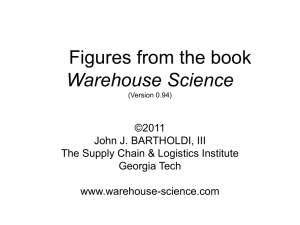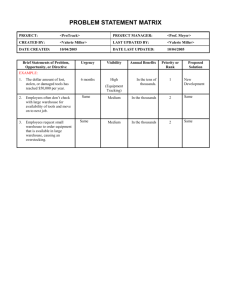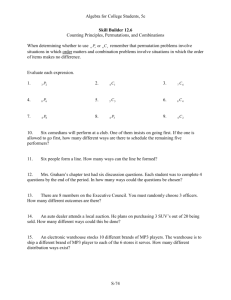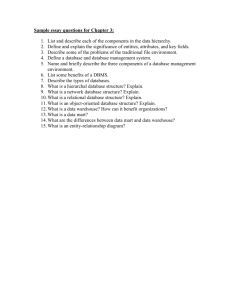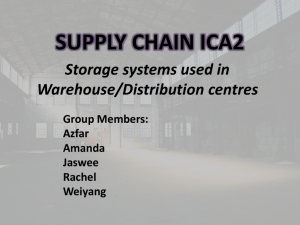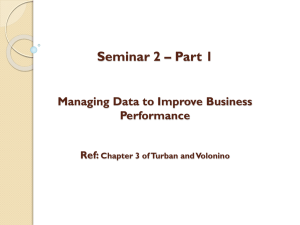GE Co-op Summary
advertisement
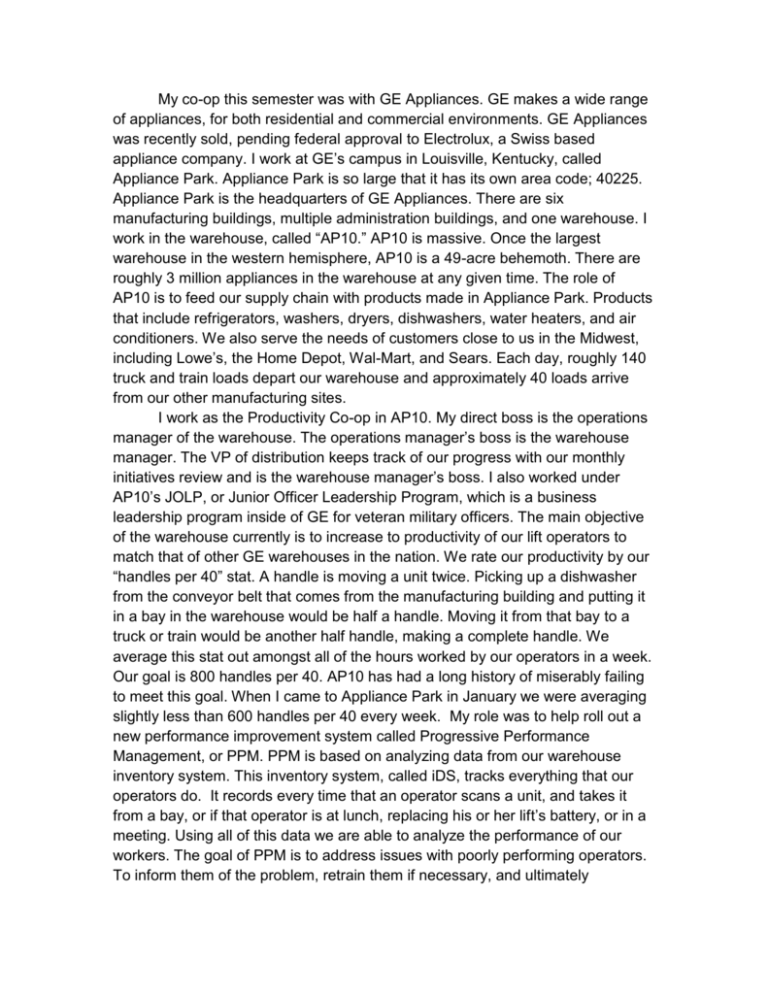
My co-op this semester was with GE Appliances. GE makes a wide range of appliances, for both residential and commercial environments. GE Appliances was recently sold, pending federal approval to Electrolux, a Swiss based appliance company. I work at GE’s campus in Louisville, Kentucky, called Appliance Park. Appliance Park is so large that it has its own area code; 40225. Appliance Park is the headquarters of GE Appliances. There are six manufacturing buildings, multiple administration buildings, and one warehouse. I work in the warehouse, called “AP10.” AP10 is massive. Once the largest warehouse in the western hemisphere, AP10 is a 49-acre behemoth. There are roughly 3 million appliances in the warehouse at any given time. The role of AP10 is to feed our supply chain with products made in Appliance Park. Products that include refrigerators, washers, dryers, dishwashers, water heaters, and air conditioners. We also serve the needs of customers close to us in the Midwest, including Lowe’s, the Home Depot, Wal-Mart, and Sears. Each day, roughly 140 truck and train loads depart our warehouse and approximately 40 loads arrive from our other manufacturing sites. I work as the Productivity Co-op in AP10. My direct boss is the operations manager of the warehouse. The operations manager’s boss is the warehouse manager. The VP of distribution keeps track of our progress with our monthly initiatives review and is the warehouse manager’s boss. I also worked under AP10’s JOLP, or Junior Officer Leadership Program, which is a business leadership program inside of GE for veteran military officers. The main objective of the warehouse currently is to increase to productivity of our lift operators to match that of other GE warehouses in the nation. We rate our productivity by our “handles per 40” stat. A handle is moving a unit twice. Picking up a dishwasher from the conveyor belt that comes from the manufacturing building and putting it in a bay in the warehouse would be half a handle. Moving it from that bay to a truck or train would be another half handle, making a complete handle. We average this stat out amongst all of the hours worked by our operators in a week. Our goal is 800 handles per 40. AP10 has had a long history of miserably failing to meet this goal. When I came to Appliance Park in January we were averaging slightly less than 600 handles per 40 every week. My role was to help roll out a new performance improvement system called Progressive Performance Management, or PPM. PPM is based on analyzing data from our warehouse inventory system. This inventory system, called iDS, tracks everything that our operators do. It records every time that an operator scans a unit, and takes it from a bay, or if that operator is at lunch, replacing his or her lift’s battery, or in a meeting. Using all of this data we are able to analyze the performance of our workers. The goal of PPM is to address issues with poorly performing operators. To inform them of the problem, retrain them if necessary, and ultimately disqualify them from working in our building or fire them from GE, depending on the issues being addressed. The program started out very inefficiently. I was tasked with creating reports using Tableau, our purchased visual data analysis software, and compiling evidence of a poor week of performance. There were many issues with this system. Outside of the time it took me to assemble these packets for our 6 or 7 worst drivers every week, the data was pretty meaningless when presented a week later. Our BTLs, or Business Team Leaders, who interact with our drivers, would ask why a particular driver had a large gap between scanning product. This would be returned by blank stares, or generalized statements about the many different places they could have been. It is tough to remember what was going on up to 8 days prior. Over time, Derek, our JOLP, and I began to develop tools in Tableau that could tell a better story. We had to validate thoroughly every new monitoring tool we created, as any mistakes would be used as ammunition by the union stewards to discredit and stall the entire PPM process. We created an “Operator Dashboard” that was accessible right on a BTL’s iPad that could be used real time to see what an operator was doing. A BTL could notice that a driver had not moved any product for 25 minutes, or was having a terribly unproductive morning, and immediately radio them to request a meeting with the driver and a union steward. Asking, “Where were you for the last half an hour,” was a much more effective question than asking about the previous week. With the help of PPM we are bringing our handles per 40 average closer and closer to 800, with individual days surpassing even 850. The management-union relationship in AP10 is slightly toxic. In fairness I am here at a pivotal time for the union. The contract is up in June, so there is a lot of talk about the upcoming negotiations between GE and the union. We are also in the middle of the sale to Electrolux and that is estimated to be finalized right about when the negotiations should be wrapping up. This toxic relationship has lead to a lot of mistrust and poor working relationships. It was also very difficult to apply discipline given the logistics of the warehouse. With 7 different BTLs and a 49-acre warehouse to hide in its not very difficult to get away with bad behavior. It is also hard to track what steps have already been taken. The union has negotiated some worker protects that are fair, but take quite a bit of time and effort on the management side to hold our workers accountable. We created an online form that could keep track of our conversations with our operators. This form was completed by a BTL every time he or she talked to an operator and had many categories, ranging from low handles to safety issues such as using ear buds or not wearing safety glasses. We created database that tracks issues with our workers and updates the BTL that oversees the worker when the next step in discipline needs to be taken. This way, repeat offenders have no choice, they either need to shape up, or they will be removed from AP10. They can no longer rely on falling through the bureaucratic cracks of the warehouse. We are attempting to fix the bad behavior, and sporadically holding our workers accountable isn’t effective or fair to them. As we automated the PPM process my time freed up. I was still involved with the continuous improvement of the program, but I was in need of a new project. I was given the task of diving into, and solving the mysteries of an area we call Refer Recoup. As I previously mentioned, there are 3 million appliances in our warehouse at a time, and thousands get moved every day. Boxes get damaged in the process. We send these damaged boxes back to recoup. Most companies will just sell these units at a reduced cost. We evaluate the damage, and depending on if the unit itself is damaged, will then repackage the unit, allowing us to sell it at full price. This area of the warehouse is particularly vulnerable as Electrolux does not have a recoup process, and may eliminate it when they come in as the new owners. The Refer Recoup area is where just refrigerators go, and is operated by 5 employees on an elevated platform. The main issue when I arrived was the lack of defined processes and knowledge of the materials. Management had no documentation of how the cell worked. Our line workers would see a refrigerator and either knew what cardboard sleeve, caps, and foams corresponded or they would not, there was no database to reference. I made what we call the Model Matrix. A spreadsheet of the roughly 115 models that goes through Refer Recoup, and all of the parts that correspond to them. It was an arduous process of asking questions to our line workers to develop the same knowledge they posses, and then consulting the thousands of technical drawings to determine what parts were necessary, which parts were redundant, and which parts could be throw out. Refer Recoup is surrounded by 9 large storage racks that carry large bundles of the parts needed to run the line. When I arrived there was no organization of the racks, and the different types of parts were scattered throughout. I installed a grid system to the racks, and labeled each shelf with color-coordinated labels, making each rack distinct and referenceable by color name. I then choreographed a relocation of the parts as efficiently possible. I made racks 1-4 for box sleeves, rack 5 for protective foam, and racks 6-9 for box caps. I analyzed our past 15 months of data to see which units were our most common, and then used our matrix to determine which parts were needed the most, or our “high runners.” The high runners were then placed in the closest spaces to the line. This was all done with the least moves as possible to save as much labor time as we could. We then installed a kanban system for recording our parts. We figured out, on average, how many of a particular part we use each week, and then established reordering points, based on lead times. If we used 10 caps every week, and those caps came from our Mexico location, the lead time would be 4 to 6 weeks, so we would always reorder when we reached roughly 80 left. We marked each shelf with a mark that would indicate to the operator that we needed to order more when our stockpile falls below that point. The operator would then go over to a cardholder, mounted on the wall, which had a two-sided card in it for each part. Both sides had the part number, and part description on them, but one side was blue and typically faced out, and the other side was orange. If an operator wanted to order more parts, he would take the card out of the holder and put it into the reordering bucket. If any of us saw a card in this bucket we would order the part, and then place the card back in the holder facing orange out, signifying that the order was on its way. Once delivered, the material handler would then return the card to its normal position, blue facing out. We then focused on material flow. Previously, one of our line operators would have to identify what box sleeve they needed and then search the racks for that part, while another would begin to search for the cap needed. We had our KPO, who is an hourly worker, responsible for building creaform structures, and anything that makes specific jobs easier, extend the refer platform and build staging racks on the line, so the operator would have to walk no more than 15 feet to any part they might need. I then had our KPO build label holders above the staging racks, and gave each part a permanent location, once again in the order of highest runners first. We repeated this process with caps and foam and eventually ended up with a well-labeled work area that a new operator, with no prior knowledge, could come in and be effective. During this time we did time studies on our workers, and noticed that the team member that scanned units in and out of refer, as well as printed new labels for reboxed units was greatly underutilized, spending more than half of their time waiting for more units to be processed. We eliminated that position and spread out the responsibilities based on who had the most free time. After we completed the rack organizing, the material flow, part labeling, and eliminated a position, we had reduced the Refer Recoup price per unit from $21 to $13. My most consistent task was related to dock safety. After a few accidents, where trucks pulled half completed loads out of the truck dock, and occasionally even taking off with one of our operators still inside the trailer the dock safety process was established. This process makes sure that every trailer is complete before a truck driver takes off with it. A dock safety sheet is printed off for every trailer with its iDS number and dock location. Once an operator has fully completed a load and closed the trailer door he or she then initials the paper and checks off that it is completed. Then the sheet is brought to the dispatch office where they radio the truck driver. My role was to check the previous day’s dock safety sheets every morning to ensure compliance and to validate the complete load stats we had for the previous day. This was essential for keeping a safe work environment, and keeping our data accurate. My co-op did not revolve around a particular software or single skill that I mastered. I instead received a wide range of experience and training. By validating Tableau results, and cross-referencing my Matrix with our inventory data I learned many great excel tricks, such as vlookup and pivot tables. I learned from LEAN experts about process best practices. I attended high-level meetings about strategic, long term planning, and ensuring a healthy relationship with our union. I feel like a much more well rounded engineer after this co-op. My rotation has given my other internship, a purchasing role in the automotive industry, some perspective and contrast. I enjoyed operations more than purchasing, but thought the automotive industry was much more stimulating, and cutting edge than consumer goods. This co-op has reaffirmed my choice to be an engineer, as I feel that I am naturally suited for this type of work, and genuinely enjoy the work life of an engineer. Upon graduation I plan on applying for positions that are a combination of all of the best aspects of my two rotations while in school. My co-op was not without difficulties. The transition from focusing on PPM to the Recoup project was not a smooth one. I initially was not very happy about my role. The nature of investigating our weak operators and creating incriminating data packs made me feel like a tattler and merely a paper pusher. This was alleviated slightly when I began to work with Derek to improve the system. Once we had created a robust system I had a few weeks of boredom. I was not very happy during this time, wondering if I had made a mistake voluntarily giving up a semester of college to come down to Louisville, to work for GE. I considered talking to my HR manager and requesting a change in position, but in the end decided that it was important to stick with what I was given and to make the best of the situation. I am proud of my perseverance and persistent efforts I made to push my management for new and challenging projects. My rotation ended up being a great success, and I think that the experience I gained dealing with a negative situation, and working to make it better was just as valuable as any technical skills and knowledge I picked up. This co-op was a wonderful learning and growing experience for me. I learned from some highly talented people about LEAN, process improvement, system design, and general leadership skills. I gained valuable experience leading a group of workers, and designing and implementing my own systems and strategies. The name recognition of GE is also valuable for me. The OMLP program is well known and highly regarded, as it has won numerous awards. This co-op has positioned me well to succeed in a large number of other types of roles. I feel confident that no matter what career path I choose going forward I will greatly helped by this unique experience.
